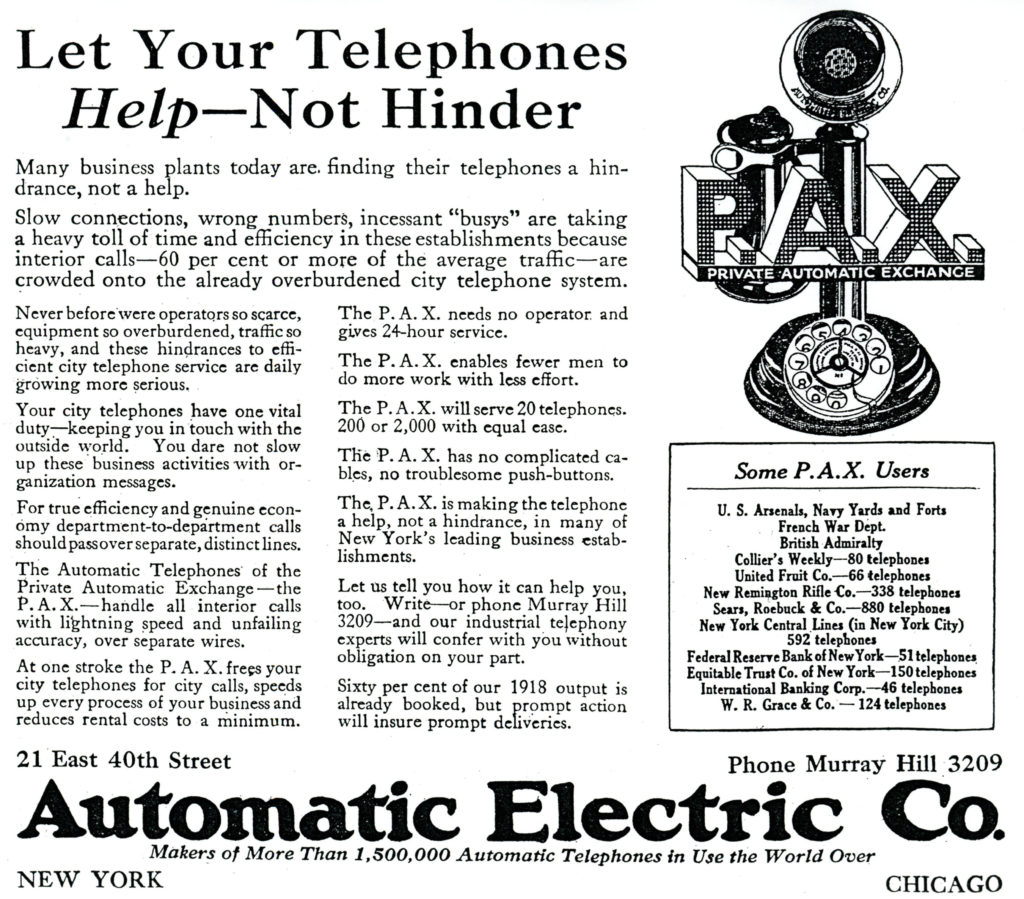A survey of The New York Times published between 1917 and the early 1920s reveals the frequent appearance of advertisements promoting devices that were the predecessors – perhaps the harbingers? – of technologies that are now pervasive. Many of these involve the communication, interpretation, storage, and retrieval of information, in the realms of manufacturing, business, and military activity. In their depictions of dress and fashion; of speech; of human interactions, these advertisements are evocative of an era that’s largely receded beyond the horizon of common thought and cultural memory.
As do all eras, in their own time.
The sometimes implied, occasionally hinted, and typically explicit message behind these advertisements – relevant to the world of 2017 – is the promotion of the benefits of new technologies for an enterprise: Enhancing human skills. Supplementing human activity. Supplanting – whether temporarily or permanently; whether fortuitously or (?!) entirely intentionally – human labor.
The image below is an example of one such advertisement.
Published in The New York Times on June 18, 1918, the ad promotes the Automatic Electric Company’s P.A.X. (Private Automatic Exchange) telephone communications system. Founded in 1901 by Almon Stowger of Kansas City, who was, “…inspired by the idea of manufacturing automatic telephone exchanges that would not require switchboard operators,” the company was acquired by General Telephone and Electronics (GT&E) in 1955, through a merger with Theodore Gary & Company. It continued operations until 1983, when it was merged by GT&E with Lenkurt into GTE Network Systems.
____________________
The advertisement – the text of which is presented below – is simple and direct, relying more on text than images. Well, hey, there’s only one image, anyway: A rotary phone.
The users of the P.A.X. system are listed below.
Irony… The system’s largest user – with 880 units – was a firm once known as Sears, Roebuck, and Company…
Some things never change.
And other things? Well, they do. And, they will.
Let Your Telephones Help – Not Hinder
Many business plans today are finding their telephones a hindrance, not a help.
Slow connections, wrong numbers, incessant “busy” are taking a heavy toll of time and efficiency in these establishments because interior calls – 60 per cent or more of the average traffic – are crowded onto the already overburdened city telephone system.
Never before were operators so scarce, equipment so overburdened, traffic so heavy, and these hindrances to efficient city telephone service are daily growing more serious.
Your city telephones have one vital duty – keeping you in touch with the outside world. You dare not slow up these business activities with organization messages.
For true efficiency and genuine economy department-to-department calls should pass over separate, distinct lines.
The Automatic Telephones of the Private Automatic Exchange – the P.A.X. – handle all interior calls with lightning speed and unfailing accuracy, over separate wires.
At one stroke the P.A.X. frees your city telephones for city calls, speeds up every process of your business and reduces rental costs to a minimum.
The P.A.X. needs no operator and gives 24-hour-service.
The P.A.X. enables fewer men to do more work with less effort.
The P.A.X. will serve 20 telephones, 200 or 2,000 with equal ease.
The P.A.X. has no complicated cables, no troublesome push-buttons.
The P.A.X. is making the telephone a help, not a hindrance, in many of New York’s leading business establishments.
Let us tell you how it can help you, too. Write – or phone Murray Hill 3209 – and our industrial telephone experts will confer with you without obligation on your part.
Sixty per cent of our 1918 output is already booked, but prompt action will insure prompt deliveries.
Some P.A.X. Users
U.S. Arsenals, Navy Yards and Forts
French War Dept.
British Admiralty
Collier’s Weekly – 80 telephones
United Fruit Co. – 66 telephones
New Remington Rifle Co. – 338 telephones
Sears, Roebuck & Co. – 880 telephones
New York Central Lines (in New York City) – 592 telephones
Federal Reserve Bank of New York – 51 telephones
Equitable Trust Co. of New York – 150 telephones
International Banking Corp. – 46 telephones
W.R. Grace & Co. – 124 telephones
References
Automatic Electric 40-60D P-A-X Business Telephone System (Promotional Brochure and Technical Specifications, at TCI (Telephone Collectors International) Library
Automatic Electric Corporation (Historical Overview)
The Disappearing PAX, at Strowger.net (“Devoted to Trailing Edge Communications”)
Intranet (general overview)
